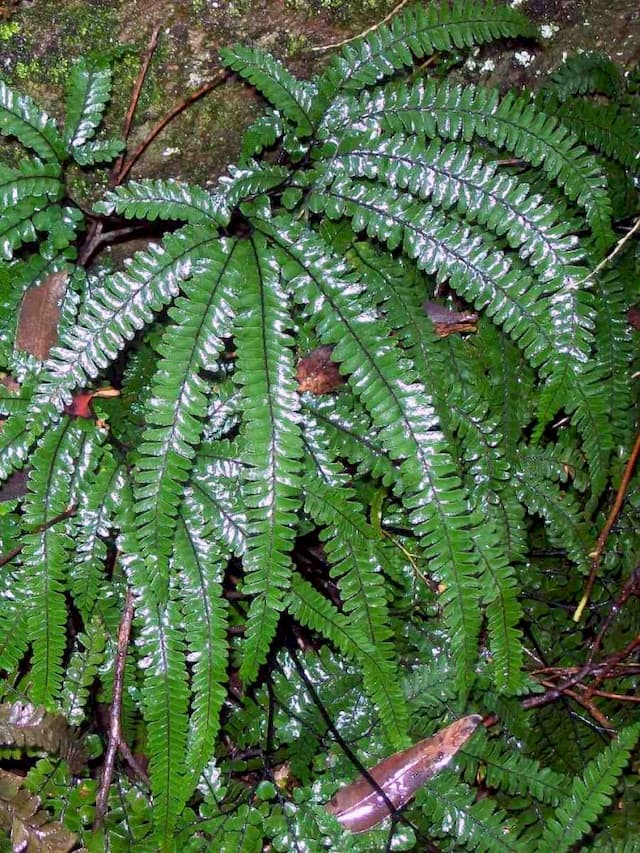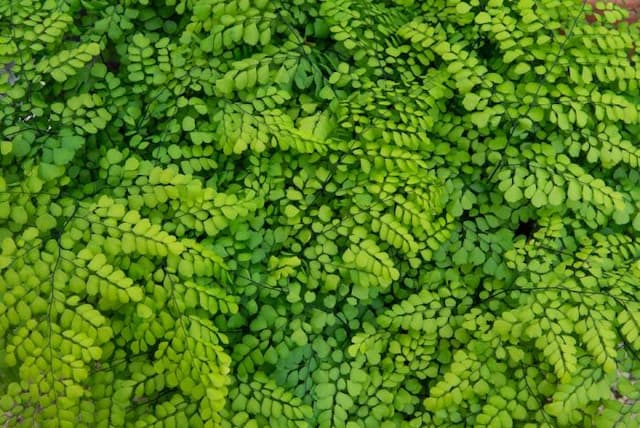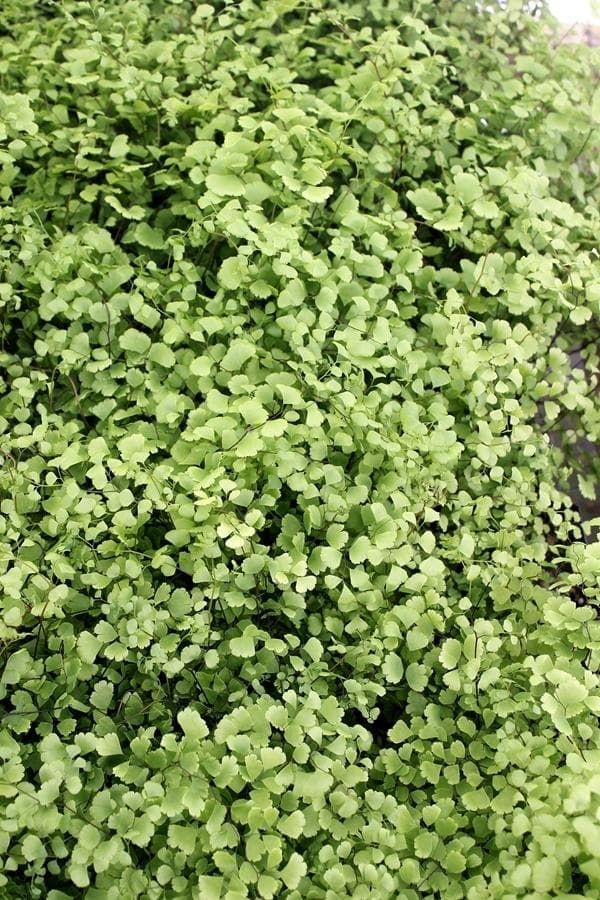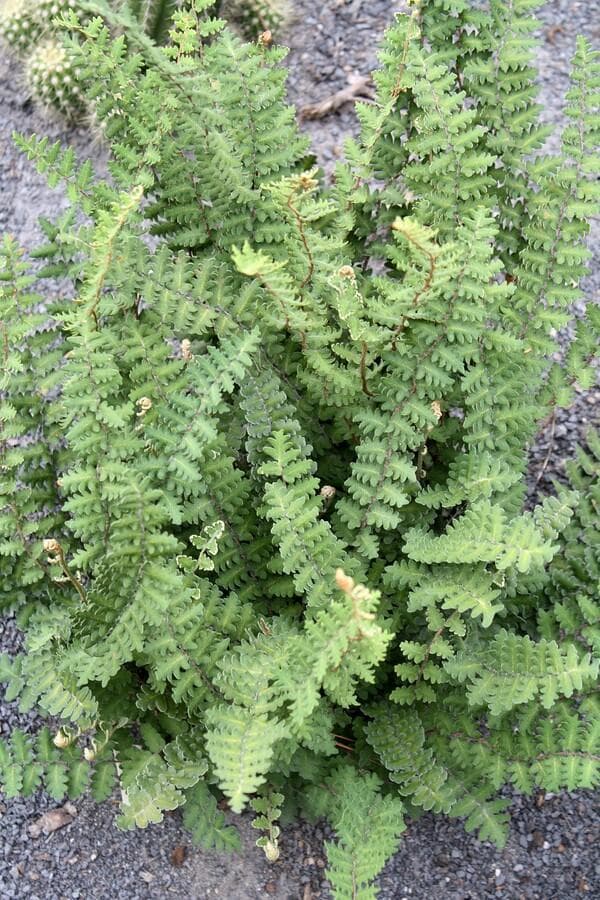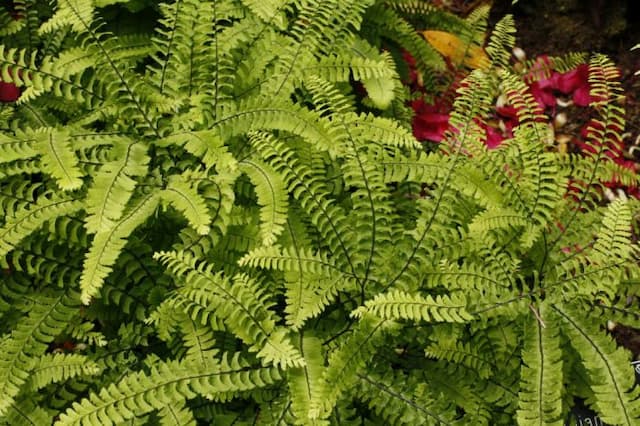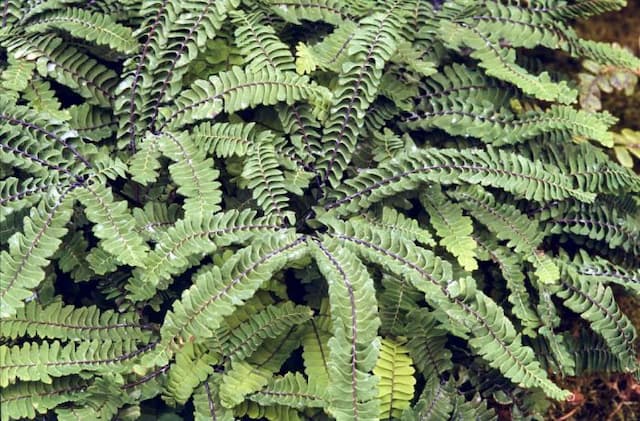Cretan brake Pteris cretica

ABOUT
The plant, commonly known as the Cretan brake, is a type of fern that has a lush and arching appearance. Its leaves, or fronds, are typically divided into segments, creating a feather-like pattern that is visually striking. Each frond has a central stem with smaller leaflets arranged on either side. These leaflets are usually pointed at the tip and can vary in color from bright green to a more muted, grayish-green, adding to the plant's overall verdant display. The leaflets’ edges tend to be slightly serrated or toothed, which gives them a somewhat delicate appearance. The Cretan brake often has a rough texture, and the stems of the fronds are often a contrasting color such as a light brown or tan, which accentuates the green of the leaves. This plant exudes a tropical feel and is known for its ability to thrive in shady environments, adding to its allure as a decorative indoor plant or garden fern.
About this plant
 Names
NamesFamily
Pteridaceae.
Synonyms
Cretan Brake, Cretan Fern, Ribbon Fern.
Common names
Allosorus creticus, Litobrochia cretica, Nephrodium creticum, Phegopteris cretica, Polypodium creticum, Pteris longifolia.
 Toxicity
ToxicityTo humans
The Pteris cretica, commonly known as Cretan brake, is not widely recognized as a toxic plant to humans. Being part of the fern family, it doesn't typically contain dangerous toxins that could cause poisoning when ingested. However, it is still not advisable to consume any part of this ornamental plant as ferns can occasionally cause gastrointestinal discomfort or allergic reactions in some individuals due to irritants like calcium oxalate crystals.
To pets
Cretan brake is also not commonly known to be toxic to pets. Ferns, in general, are considered to be quite safe for animals, and there are no well-documented cases of serious toxicity involving pets ingesting Pteris cretica. Still, it is generally recommended to prevent pets from eating houseplants, as they can potentially cause mild digestive upset or an allergic reaction even when they are not toxic.
 Characteristics
CharacteristicsLife cycle
Perennials
Foliage type
Evergreen
Color of leaves
Green
Height
1-3 feet (0.3-0.9 meters)
Spread
1-2 feet (0.3-0.6 meters)
Plant type
Fern
Hardiness zones
10
Native area
Mediterranean
Benefits
 General Benefits
General Benefits- Easy Maintenance: Cretan brake requires minimal care and can thrive in a variety of indoor conditions, making it an excellent choice for novice gardeners.
- Adaptability: It adapts well to different light conditions, from low to bright, indirect light, which suits various indoor environments.
- Decoration: With its attractive fronds and distinctive appearance, Cretan brake adds aesthetic appeal to interior spaces.
- Humidity Tolerance: This fern is tolerant of moist conditions, making it a good choice for bathrooms and kitchens where humidity levels are higher.
- Temperature Resilience: It can withstand a range of temperatures common in homes and offices, ensuring robustness in different seasonal conditions.
- Non-Toxic: Cretan brake is non-toxic to pets and humans, making it a safe addition to any home.
- Soil Versatility: It is not very picky about soil type, allowing it to grow in a mixture that might not be ideal for other plants.
 Medical Properties
Medical PropertiesThis plant is not used for medical purposes.
 Air-purifying Qualities
Air-purifying QualitiesThis plant is not specifically known for air purifying qualities.
 Other Uses
Other Uses-
Pteris cretica, commonly known as the Cretan brake fern, can be used in terrariums due to its small size and adaptability to humid environments.
-
It is often used in floral arrangements and as filler greenery because its fronds add a delicate and feathery texture to bouquets.
-
Cretan brake fern is suitable for use in hanging baskets, where its arching fronds can cascade beautifully over the edges.
-
This fern can be a teaching tool in botany classes to help students learn about plant morphology and reproduction, especially fern life cycles.
-
As a model organism, Pteris cretica serves in scientific research, particularly in studies of fern genetics and environmental adaptation.
-
Cretan brake fern may be incorporated in green roofs or living wall installations due to its ability to thrive in shallow substrate and partial shade.
-
This plant is used in the art of bonsai, where miniaturized ferns create a forest floor effect when displayed with trees.
-
Designed landscapes, such as Japanese gardens or shade gardens, frequently make use of ferns like Pteris cretica for their aesthetic foliage and soft structure.
-
It can be utilized as ground cover in shaded areas of the garden where other plants might struggle to grow due to low light levels.
-
Pteris cretica's fronds are sometimes used in craft projects, such as botanical prints, where they're pressed and dried to create natural art pieces.
-
Interesting Facts
 Feng Shui
Feng ShuiThe Cretan brake fern is not used in Feng Shui practice.
 Zodiac Sign Compitability
Zodiac Sign CompitabilityThe Cretan brake fern is not used in astrology practice.
 Plant Symbolism
Plant Symbolism- Resilience: Pteris cretica, commonly known as Cretan brake, can thrive in a range of conditions, symbolizing the ability to endure and adapt to varying environments.
- Elegance: The delicate and intricate fronds of the Cretan brake represent grace and refined beauty.
- Regrowth: As a fern that can regenerate from its rhizomes, Cretan brake symbolizes new beginnings and the cycle of life.
- Shelter: With its tendency to form dense clumps, Cretan brake can symbolize protection and providing a safe haven.
- Secretiveness: In Victorian floriography, ferns often represented secretiveness or confidentiality, due to their secluded growth habitats.
 Water
WaterThe Cretan brake fern (Pteris cretica) prefers consistently moist soil, which means it should be watered approximately every 5 to 7 days. The frequency depends on factors like humidity and temperature. You should water the plant thoroughly, allowing the top inch of soil to dry out slightly between waterings. Depending on the size of your pot, watering with roughly 8 to 16 ounces of water should be sufficient to keep the soil suitably moist without causing waterlogging.
 Light
LightCretan brake fern thrives in bright, indirect light. It is best to place it in a spot where it will receive filtered sunlight, away from direct rays, which can scorch the delicate fronds. An east or north-facing window is ideal for providing the needed light conditions without exposing the plant to harsh direct sunlight.
 Temperature
TemperatureCretan brake fern prefers a warm environment with temperatures ranging from 60 to 75 degrees Fahrenheit. The minimum temperature it can tolerate is around 55 degrees Fahrenheit; exposure to colder temperatures can harm the plant. For best growth, maintain an average room temperature within the preferred range and avoid sudden temperature drops.
 Pruning
PruningPruning of the Cretan brake fern is typically done to remove brown or damaged fronds, which encourages healthy new growth. It is best to prune in the spring or as needed throughout the growing season. Use clean, sharp scissors to snip off the unwanted fronds at the base, being careful not to damage the healthy parts of the plant.
 Cleaning
CleaningAs needed
 Soil
SoilThe Cretan Brake Fern thrives best in a well-draining soil mix that is rich in organic matter. A blend of peat, perlite, and pine bark would create an ideal environment, with a pH ranging from slightly acidic to neutral (6.0 - 7.0).
 Repotting
RepottingCretan Brake Fern should be repotted every 1 to 2 years to refresh the soil and allow room for growth. Mature plants may be repotted less frequently, only when the pot becomes root-bound.
 Humidity & Misting
Humidity & MistingCretan Brake Fern prefers high humidity levels, generally around 60% or higher. To achieve this, it might be necessary to use a humidifier or place a water tray near the plant.
 Suitable locations
Suitable locationsIndoor
Place in bright, indirect light with high humidity.
Outdoor
Part shade, shelter from wind, keep soil moist.
Hardiness zone
9-11 USDA
 Life cycle
Life cycleThe life cycle of the Cretan Brake (Pteris cretica) begins with the spore, the reproductive unit of the fern that disperses from the parent plant to germinate in suitable moist conditions. Upon germination, the spore develops into a small, heart-shaped gametophyte, often referred to as the prothallus, which is the sexual phase of the fern and contains both male and female reproductive organs. Once the gametophyte is mature, it undergoes fertilization when water allows sperm to swim to the eggs, resulting in the formation of a zygote. This zygote then grows into the sporophyte, the typical fern plant we recognize, developing roots, a rhizome, and fronds. The fronds uncurl as they mature in a process called circinate vernation and eventually produce sori on their undersides, which are clusters of sporangia that produce and release new spores to continue the cycle. The mature Cretan Brake fern is characterized by its arching, pale green fronds, which can reproduce vegetatively through rhizome division or sexually via the spores produced in the sori.
 Propogation
PropogationPropogation time
Spring to Summer
The most popular method of propagating the Cretan brake fern, or Pteris cretica, is through division. This is typically done in the spring or early summer when the plant's growth is most vigorous. To propagate by division, carefully remove the fern from its pot and use your hands or a sharp knife to divide the root ball into smaller sections, ensuring that each section has at least one frond and a section of root. These divisions can then be potted separately in a mix of peat and perlite or a well-draining potting mix. Water the newly potted divisions thoroughly and place them in a location with indirect light, maintaining moist but not soggy soil conditions until new growth indicates that the division has successfully taken root. This method of propagation allows for the easy and effective multiplication of Cretan brake ferns, making it an excellent choice for gardeners looking to expand their collection or share with others.

